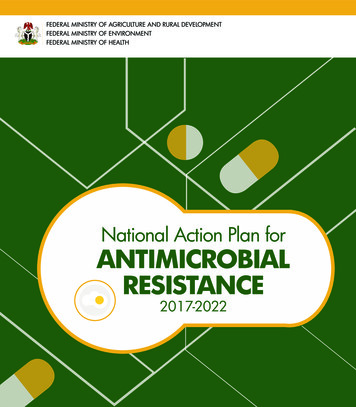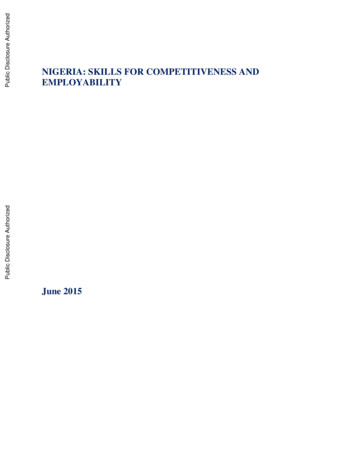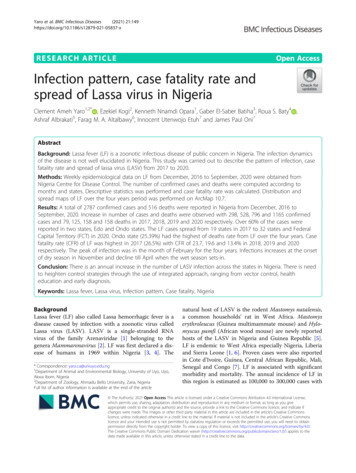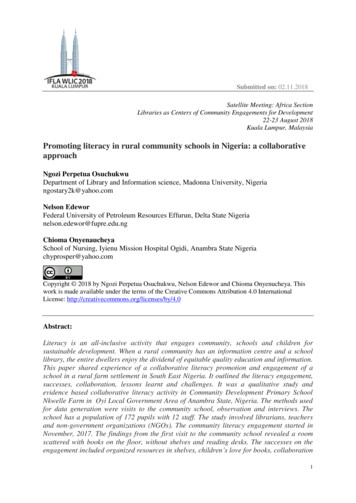
Transcription
Foreword.Acknowledgement.Abbreviations and Acronyms.Executive Summary.1. Background.Country Profile.689131616Health system.2. AMR Situation in Nigeria.Introduction.Antimicrobial Use and Resistance.AMR Governance.Key Achievements and Challenges.3. Strategic Plan.Focus Area 1: Increasing Awareness and Knowledge of AMR and Related Topics.Focus Area 2: Building a ‘One Health’ AMR Surveillance System.Focus Area 3: Intensifying Infection Prevention and Control in the Tripartite Sectors.Focus Area 4: Promoting Rational Access to Antibiotics and Antimicrobial Stewardship.Focus Area 5: Investing in AMR Research and Development.4. Operational Plan.5. Monitoring and Evaluation.Monitoring and Evaluation 598List of Contributors. 100
TablesTable 1: SWOT Grid of AMR Situation Analysis.26FiguresFigure 1: Organogram of the National Amr Prevention and ControlGovernance Structure.Figure 2: Proposed information Flow Structure for AMR Activities.25945
ACSMADRAdvocacy, Communication and Social MobilisationAdverse Drug ReactionAFENETAfrican Field Epidemiology NetworkAIDSAcquired Immunodeficiency SyndromeAMRAntimicrobial ResistanceAMR-TWGAntimicrobial Resistance Technical Working GroupAMSAntimicrobial SurveillanceAPINAIDS Prevention Initiative in NigeriaARIAcute Respiratory InfectionsBCCBehaviour Change CommunicationBSIBlood Stream InfectionsCBOCommunity Based OrganisationsCDDEPCenter for Disease Dynamics, Economics and PolicyCEOChief Executive OfficerCFRCase Fatality RateCHWCOMOCORPCommunity Health WorkerCommunity Mobilisation OfficerCommunity Resource PersonCPDContinuous Professional DevelopmentCRECarbapenem-Resistant EnterobacteriaceaeCSMCCommunication and Social Mobilisation CommitteeCSOCivil Society Organisation;ECOWASEconomic Community of West African StatesEDLEssential Drugs ListESBLExtended-Spectrum Beta-LactamaseFAOFood and Agricultural OrganisationFAQFrequently Asked QuestionsFBOFaith Based Organisations
National Action Plan for Antimicrobial Resistance, 2017-202210FCTFederal Capital TerritoryFDSFood and Drug ServicesFMARDFederal Ministry of AgricultureFMEnvFederal Ministry of EnvironmentFMoEdFederal Ministry of EducationFMoFFederal Ministry of FinanceFMoHFederal Ministry of HealthFMoIFederal Ministry of InformationGARPGlobal Antibiotic Resistance PartnershipGDPGross Domestic ProductGLASSGlobal Antimicrobial Resistance Surveillance SystemGMPGood Manufacturing PracticesHAIHealthcare associated infectionsHCPHealth care practitionerHIVHuman Immunodeficiency VirusHMOHealth Management OrganisationHPDHealth Promotion DepartmentIECInformation, Education, CommunicationIHVNInstitute of Human VirologyIPCInfection Prevention and ControlLGALocal Government AreaMDAsMinistries, Departments and AgenciesM&EMonitoring and EvaluationMOEBPMinistry of Economy and Budget PlanningMOTIMarketing On The InternetNAFDACNational Agency for Food and Drug Administration and ControlNAPNational Action PlanNBCCCGNational Behaviour Change Communication Consultative Group
National Action Plan for Antimicrobial Resistance, 2017-2022NCANational Council on AgricultureNCCNational Coordinating CentreNCDCNigeria Centre for Disease ControlNCHNational Council on HealthNGONon-Governmental OrganisationNHISNational Health Insurance SchemeNHMISNational Health Management Information SystemNICANigeria Infection Control AssociationNIDSNigeria Infectious Disease SocietyNIMRNational Institute of Medical ResearchNOANational Orientation AgencyNOTAPNational Office for Technology Acquisition and PromotionNPHCDANational Primary Healthcare Development AgencyNSANational Security AdviserNSCNational Steering CommitteeNTSNon-Typhoidal SalmonellaNTWGNational Technical Working GroupNUCNational Universities CommissionNUJNigeria Union of JournalistsNVMANigerian Veterinary Medical AssociationNVRINational Veterinary Research InstituteOIEWorld Organisation for Animal HealthOOPOut-of-PocketPPMVsPatent and Proprietary Medicine VendorsPTProficiency TestingPTAParent-Teacher AssociationPVCPharmacovigillance committeeOIE-PVSOIE Performance, Vision and StrategyFederal Ministries of Agriculture, Environment and Health; September 201711
National Action Plan for Antimicrobial Resistance, 2017-202212REDDISERegional Disease Surveillance Systems EnhancementSBCCSocial and Behaviour Change CommunicationSCSMCState Communication and Social Mobilisation CommitteeSLIPTAStep-wise Laboratory Improvement Process Towards AccreditationSMARDState Ministry of AgricultureSMCSocial Mobilisation committeeSMESmall and Medium-sized EnterpriseSMoEnvState Ministry of EnvironmentSMoHState Ministry of HealthSMoIState Ministry of InformationSQHNSociety for Quality in HealthcareSTGStandard Treatment GuidelinesSTWGState Technical Working GroupSWOTStrengths, Weakness, Opportunities and ThreatsTORTerms of ReferenceTWGTechnical Working GroupUNUnited NationsUNICEFUnited Nations International Children's Emergency Fund United States DollarUTIUrinary Tract InfectionVCNVeterinary Council of NigeriaVREVancomycin Resistant EnterobacteriaceaeWERWeekly Epidemiology ReportWHAWorld Health AssemblyWHOWorld Health Organisation
EExecutive SummaryNigeria has an estimated population of 182 million people, which is expected torise to over 200 million by the year 2025. In 2013, the life expectancy at birth inNigeria was estimated at 54 years. Poverty is a major contributor to the worseninghealth status of Nigerians, which has declined over the decade. Orthodox healthcare services in Nigeria are provided from the private and public sectors at primary,secondary and tertiary levels. The primary health care level is entry point into thehealth care system and includes health centres, clinics, dispensaries and health posts.Despite rapid urbanization, health and economic inequalities continue to exist andsignificantly contributes to health care access. Whilst non-communicable illnesses aregaining prominence, infections continue to be the most common cause of illness anddeath in all parts of Nigeria. Treatment of the most common infections – malaria,tuberculosis, respiratory infections, diarrhoeal diseases and sexually transmittedinfections, including HIV is presently being compromised by antimicrobial resistance.There is therefore a pressing need to contain the problem.Antimicrobial Resistance and GovernanceAntimicrobial resistance (AMR) has grown in prominence to compromise treatmentsfor almost all human and animal diseases caused by bacteria, parasites, viruses andfungi. The most vulnerable patients bear the brunt of the impact, as AMR increasestreatment costs and can also prolong illness, worsen disability and increase mortality.The precise magnitude of AMR and its true impact on health care delivery and itscosts are still largely unknown.In May 2015, the 68th World Health Assembly (WHA), recognising AMR as athreat to global health, passed WHA resolution 68.7 requesting that Member Statesdevelop or adopt country-specific action plans in line with the Global Action Plan onAMR. The Global Antimicrobial Resistance Surveillance System (GLASS) was alsoinstituted in September 2015, five months after adoption of Global Action Plan. TheFederal Ministries of Agriculture, Environment and Health; September 201713
National Action Plan for Antimicrobial Resistance, 2017-2022Nigerian Honourable Minister of Health, on the 26th of November 2016, approvedthe establishment of Nigeria’s National AMR Coordinating Body at the NigeriaCentre for Disease Control (NCDC). A National AMR Technical Working Group(AMR-TWG) was created comprising stakeholders from human health, animal health,food animal production and environment sectors. The AMR-TWG was tasked withconducting a situation analysis of AMR in Nigeria and designing a National ActionPlan for AMR containment in the country. The full situation analysis is contained in aseparate document. This Action Plan details objectives derived from analyzing thestrengths, weaknesses, threats and opportunities of the National AMR situation andmaking recommendations based on the five strategic objectives of the Global ActionPlan on AMR.The following priority gaps were identified;1. Poor public awareness and weak coordination of AMR awareness activities bygovernment and partners such as vertical disease control programmes.2. Poor ‘One Health’ coordination of animal and human national diseasesurveillance systems, non-existence of a national AMR laboratory surveillancesystem and no dedicated funding for AMR control activities3. Non-existence of a national Infection Prevention and Control (IPC) coordinatingbody or guidelines, and poor budgetary support for IPC activities in healthfacilities4. Lack of antimicrobial stewardship in both private and public sectors5. A complete absence of studies on the health and economic impact of AMR inNigeria and poor coordination of research on antibiotic use14
National Action Plan for Antimicrobial Resistance, 2017-2022Strategic PlanThe goal of the action plan is to reduce, prevent and slow the evolution of resistantorganisms and their impact on health care while ensuring optimal use and improvedaccess to effective, safe and quality-assured antimicrobials for continued successfulmanagement of infections.The plan incorporates the one health approach and aims at implementing proposedactions by strengthening and utilizing existing national systems or by creating newstructures where they do not exist. The focus areas are;1. Increasing awareness and knowledge on AMR and related topics2. One health AMR surveillance and research3. Infection Prevention and Control in the tripartite sector4. Promote rational access to antibiotics and Antimicrobial stewardship5. Invest in research to quantify the cost of resistance and develop newantimicrobials and diagnosticsThis document also details the strategic interventions for each objective, activity,budget and the monitoring/evaluation plan for all activities.Federal Ministries of Agriculture, Environment and Health; September 201715
1BackgroundCountry ProfileNigeria is the most densely populated country in Africa being a federation of 36States and a Federal Capital Territory at Abuja, operating a three-tiered governmentstructure. It has an estimated population of 182 million people which is expectedto rise to over 200 million by the year 20251,2. The official language is English butthere are about 374 identifiable ethnic groups in Nigeria with Igbo, Hausa, andYoruba representing the major groups and languages spoken3. The country’s differentreligions include Islam, Christianity, and traditional African beliefs. The nationalmedian age is 17.2 years and the proportion of children aged below 15 years isaround 46%, while the proportion of individuals aged 65 years and older is 4%3,4.The literacy rate for persons 15 years and older in 2015 was 60%5. In 2013, thelife expectancy at birth in Nigeria was estimated at 54 years6. The infant mortalityrate is 69 per 1,000 live births while the under-five mortality rate is 128 per 1,000live births3. The maternal mortality ratio is 576 deaths per 100,000 live births in thecountry, one of the highest in the world3.In 2015, Nigeria’s Gross Domestic Product (GDP) was 481bn with an annualgrowth rate of 2.7%7.The National Bureau of Statistics reported that the contributionof agriculture to the total GDP was 23%8in that year. Poverty remains a majorcontributor to the worsening health status of Nigerians as 76% of its population stilllive on 3.10 a day or less9. In the face of rapid urbanisation, health and economicinequalities continue to contribute to poor health care access2,3.Health SystemOrthodox health care services in Nigeria are provided by both private and publicsectors with the public health service organised into primary, secondary and tertiarylevels. In 2005, it was estimated that 23,640 health facilities existed in Nigeria;85.8% being primary health care facilities, 14% secondary and 0.2% tertiary care16
National Action Plan for Antimicrobial Resistance, 2017-2022institutions 10. About 60% of the public primary health care facilities are in Nigeria’snorthern geopolitical zones10. This primary level of care is the usual entry point ofcommunities into the health system and it includes health centres, dispensaries, andhealth posts which typically provide general preventive, curative and pre-referralcare2. Community Health Workers (CHWs) provide the majority of the servicesat primary care centres2. Secondary care facilities provide both general medicalservices as well as some specialised health services2. Tertiary facilities whichprovide the highest level of health care in the country, are also training centres formedical students and they include specialist/teaching hospitals and Federal MedicalCentres2. There is a tertiary facility in every State, with a few having more than one.The National Health Policy ascribes responsibilities for primary health care tothe 774 local governments, secondary care to the States and tertiary care to thefederal government. At the local government level, a Chairman administers healthservices, assisted by an officer designated to head the health department. Theseofficers are mandated to finance and manage primary health care facilities11. Thesecondary health care facilities are under the purview of State Ministries of Health,which are overseen by State Commissioners of Health. Some States have a HealthManagement Board to specifically manage their health facilities11. The responsibilityfor tertiary care and training lies with the Federal Government2,11 through the FederalMinistry of Health which is headed by the Minister. Many States periodicallyorganise a State Council of Health meeting to obtain consensus on health issuesbetween the local and state governments. The Minister of Health also meets withState commissioners of Health during the ‘National Council on Health’ meeting11 toobtain consensus on health issues between the state and federal levels. Each levelof government is however largely autonomous in the financing and management ofits health services, though guided by policies formulated by the Federal Ministry ofHealth.Federal Ministries of Agriculture, Environment and Health; September 201717
218AMR Situation in Nigeria
National Action Plan for Antimicrobial Resistance, 2017-2022Federal Ministries of Agriculture, Environment and Health; September 201719
National Action Plan for Antimicrobial Resistance, 2017-202220
National Action Plan for Antimicrobial Resistance, 2017-2022Federal Ministries of Agriculture, Environment and Health; September 201721
National Action Plan for Antimicrobial Resistance, 2017-202222
National Action Plan for Antimicrobial Resistance, 2017-2022Federal Ministries of Agriculture, Environment and Health; September 201723
National Action Plan for Antimicrobial Resistance, 2017-2022TABLE 1: SWOT GRID OF AMR SITUATION ANALYSISSTRENGTHS Existence of national health policies, regulations and guidelines on treatment ofinfections in humans and animals, antimicrobial use (including IPC and traditionalmedicine use), environment protection, food safety and vaccination Existence of regulatory councils for health, agricultural and environmental workers Availability of the National Health Insurance Scheme Established disease surveillance notification structure at the NCDC Existence of potential infrastructure for laboratory surveillance of bacterial resistance Availability of AMR training curriculum in universities (undergraduate andpostgraduate) Presence of predominantly indigenous pharmaceutical manufacturers; some haveacceptable level of compliance with WHO Good Manufacturing Practices (GMP)guidelines Availability of a national drug policy Establishment of national procurement policy and a dedicated procurementdepartment Existence of waste management guidelines (including for pharmaceutical waste)WEAKNESSES Existence of National Health Promotion Policy and institutionalised health promotionpractice in Nigeria Propensity for corruption in healthcare fund and commodities management Poor government insurance coverage and high out-of-pocket (OOP) expenses Studies on economic impact of AMR in Nigeria are non-existent Guidelines on antibiotic use in humans/animals are outdated, poorly disseminatedand not adhered to, policy on antimicrobial (including alternatives) use is poorlyimplemented and regulatory agencies are underfunded Limited number of accredited training institutions and health worker to populationratio is low Poor ‘One Health’ coordination of animal and human national disease surveillancesystems26
National Action Plan for Antimicrobial Resistance, 2017-2022TABLE 1: SWOT GRID OF AMR SITUATION ANALYSIS CONT’DWEAKNESSES Lack of antimicrobial stewardship in both private and public sectors Weak primary healthcare systems National committee on AMR is non-existent and there is no AMR surveillancesystem Lack of a national reference laboratory for AMR and few quality-assuredmicrobiology laboratories Lack of coordination of, and comprehensive national reports on nationalantibiotics consumption Inadequate number of indigenous pharmaceutical manufacturers and overreliance on imported pharmaceuticals IPC domiciled in Department of Public Health with poor collaboration withDepartment of Hospital Services in the Federal Ministry of Health Weak coordination of AMR awareness activities implemented by government andpartners and poor public awareness of AMROPPORTUNITIES Problem of unskilled prescribers of antibiotics Development of a National surveillance system and GLASS enrolment Increasing multi-stakeholders’ participation and interest in AMR Integration of traditional medicine into the national health system and increasinggovernment commitment to research on antimicrobial alternatives to reducereliance on antibiotics use Possibility of using HMO provider audits to institute antimicrobial education andstewardship among private practice providers Leveraging on existing health policies and surveillance systems in the tripartitesectors to build AMR surveillance system Availability of accredited laboratories within vertical programme Availability of World Bank supported 90m REDDISE (Regional DiseaseSurveillance Systems Enhancement) fund using the ‘One Health’ approachFederal Ministries of Agriculture, Environment and Health; September 201727
National Action Plan for Antimicrobial Resistance, 2017-2022TABLE 1: SWOT GRID OF AMR SITUATION ANALYSIS CONT’DOPPORTUNITIES Establishment of more indigenous manufacturing companies for development ofnew antimicrobials Review and implementation of the national drug policy Setting up of more drug distribution centres in some States Grazing bill could be adapted to include AMR awareness Targeting annual conferences, national forums (NCH, NCA), CPD andcommittees (Livestock Development Committee) in the tripartite sector foradvocacy activitiesTHREATS Leveraging on the existing Communication and Social Mobilisation structures atall levels for public awareness creation activities National issues: recession, corruption, one federation account and insurgency Health workers’ attrition in general, particularly in rural areas Poor enforcement of regulations and policies on AMR control and prevention Weak pharmacovigilance of antibiotics Funding – no dedicated budget line for AMR control and surveillance Poor coordination of research on antibiotic use Chaotic drug distribution system in the private sector, high level of counterfeitmedicines in circulation and smuggling-in unregistered medicines Unregistered practitioners and prescription of antibiotics by unlicensed persons Poor management of waste from pharmaceutical processes and expired drugs Inadequate funding of indigenous pharmaceutical companies Lack of community pharmacies in rural areas and sale of prescription medicinesby PPMVs Non-qualification of courier services used in the delivery of thermo-labilemedicines and diagnostics Non-regulation of AMR activities (awareness, training, etc.) by partners such asvertical programmes28
National Action Plan for Antimicrobial Resistance, 2017-2022The following priority gaps were identified;1. Poor public awareness and weak coordination of AMR awareness activities bygovernment and partners such as vertical disease control programmes.2. Poor ‘One Health’ coordination of animal and human national diseasesurveillance systems, non-existence of a national AMR laboratory surveillancesystem and no dedicated funding for AMR control activities3. Non-existence of a national Infection Prevention and Control (IPC) coordinatingbody or guidelines, and poor budgetary support for IPC activities in healthfacilities4. Lack of antimicrobial stewardship in both private and public sectors5. Studies on the health and economic impact of AMR in Nigeria and poorcoordination of research on antibiotic useFederal Ministries of Agriculture, Environment and Health; September 201729
ObjectivesStrategic interventions1.1 Increase awareness ofAMR among Nigeriansby 20221.1.1. Establish an evidence-based public communicationprogramme targeting the public and audiences in human,animal and environmental health under the leadership of atripartite AMR National Behaviour Change CommunicationConsultative Group (NBCCCG)1.1.2. Conduct high-level advocacy visits to policy makers andrelevant stakeholders to create budget lines and source forrequired financial and technical support for AMR awarenessprogrammes in the 36 States, FCT and at the Federal level1.1.3. Implement communication campaigns to increase awarenessof appropriate antimicrobial use and the adoption of infectionprevention measures among the public, policy makers, human,animal and environmental professionals and other relevantstakeholders in communities, schools, workplaces and healthfacilities1.2 Improve knowledge ofAMR and related topics1.2.1. Strengthen regulatory systems to promote rationalantimicrobial use, infection prevention and antimicrobialstewardship among human health, animal health, environmentand allied professionals1.2.2. Augment the knowledge and understanding of AMR, IPC,biosecurity and antimicrobial stewardship among human,animal, and environmental health care and allied professionals
National Action Plan for Antimicrobial Resistance, 2017-2022Focus Area 2: Building a ‘One Health’ AMR surveillance systemCollaboration across the health, animal health and environmental health sectors is largely minimalor non-existent. The focus is on setting up a national AMR surveillance system using a ‘One Health’approach and strengthening institutional capacities (e.g. of laboratories) for early AMR detectionObjectivesStrategic interventions2.1Set up a national surveillancesystem for AMR2.1.1 Establish a national coordination structure forsurveillance of AMR2.1.2 Develop a multi-sectoral surveillance implementationplan2.2 Strengthen institutionalcapacities for early AMRdetection and trendsmonitoring in the country2.2.1 Develop sector-specific surveillance protocols to detectemerging, re-emerging and changing trends in AMR2.2.2 Prepare and implement a Human Resource DevelopmentPlan for AMR Surveillance2.3 Build laboratory capacityto produce high-qualitymicrobiological data tosupport surveillance activitiesacross all sectors2.3.1. Set up an NCDC National Reference Laboratory2.4 Contribute to Globalsurveillance2.4.1. Enroll in GLASS2.5 Build and implement aresearch agenda for AMRburden assessment2.5.1 Capacity Building of AMR Researchers2.3.2. Standardise laboratory capacity for monitoring AMR(Human, Terrestrial and Aquatic Animal, Food andEnvironment)2.4.2 Contribute National Surveillance data to GLASS2.5.2. Periodically identify and articulate surveillance gapsand AMR burden estimation needs2.5.3. Secure funding from relevant public and private sources2.5.4. Commission researchers and research institutions toundertake research in identified gaps32
National Action Plan for Antimicrobial Resistance, 2017-2022Focus Area 3: Intensifying Infection Prevention and Control in thetripartite sectorsInfection prevention and control and good hygiene practices are key to reducing antibioticconsumption and the development of resistance. This strategy focuses on strengthening theinfection prevention and control programme in human health, animal health and the environment atcommunity and all governmental levels, promoting food safety and the use of vaccines in humansand animals.ObjectivesStrategic interventions3.1 Strengthen infectionprevention and control at allgovernmental levels and inhealth care facilities3.1.1 Establish a National Infection Prevention and ControlProgramme3.2 Promote infection preventionand control in animal health3.2.1 Introduce IPC programme into veterinary practice andaquatic and terrestrial animal husbandry3.1.2 Strengthen IPC practices3.1.3 Improve IPC education and training3.2.2 Improve IPC and farm biosecurity practices3.2.3 Include hygiene and infection prevention and control ascore (mandatory) content in training and education ofveterinary professionals and animal health practitioners3.2.4 Improve IPC education and training for veterinarypractice and aquatic and terrestrial animal husbandry3.3 Promote food safety3.3.1 Support implementation of food safety guidelines at thecommunity level3.4 Improve infection preventionand control practices at thecommunity level3.4.1 Improve access to potable water in communities andwithin healthcare facilities3.5 Improve environmentalsanitation and hygiene3.5.1 Improve waste management practices3.4.2 Ensure water quality standard3.5.2 Support safe disposal and management of sewage andfecal matterFederal Ministries of Agriculture, Environment and Health; September 201733
National Action Plan for Antimicrobial Resistance, 2017-2022Focus Area 3: Intensifying Infection Prevention and Control in thetripartite sectors cont’dObjectivesStrategic interventions3.6 Improve hygienic practices atthe community level3.6.1 Promote hand hygiene at the community level and inschools3.7 Increase the use of vaccinesto prevent new infections inhumans and animals3.7.1 Scale up immunisation coverage in human and animalhealth sectors3.7.2 Increase range of available vaccines in–country for bothhuman and animal health3.7.3 Support surveillance of vaccination programmes inhuman and animal health to enable appropriatevaccination34
National Action Plan for Antimicrobial Resistance, 2017-2022Focus Area 4: Promoting Rational Access to Antibiotics andAntimicrobial StewardshipIn Nigeria, antibiotic sale and use is poorly regulated and monitored. The strategy is to improveaccess to quality antimicrobial agents for infections, promote antimicrobial stewardship andstrengthen regulatory agencies across all sectors (humans, animals and environment).ObjectivesStrategic interventions4.1 Improve access to qualityantimicrobial agents forinfections in humans andanimals4.1.1 Promote optimal procurement and distribution of qualityantimicrobials and diagnostics for human and animaluse4.1.2. Enhance local production of quality antimicrobialagents and diagnostics for human and animal use4.1.3. Expand NHIS coverage to include more enrollees4.2 Promote antimicrobialstewardship in human andanimals4.2.1 Promote the use of up to date treatment guidelines andensure prudent use in humans and animals4.3 Strengthen regulatoryagencies across all sectors(humans, animals andenvironment) to enable themperform their mandate withregards to antimicrobials4.3.1 Strengthen the capacity of regulatory agencies across‘One Health’ sectors (i.e. human, animals, food productsand environment)4.2.2 Promote optimal prescribing and dispensing ofantimicrobials in humans and animals4.3.2 Enhance inter-sectoral coordination and collaborationbetween/amongst regulatory agenciesFederal Ministries of Agriculture, Environment and Health; September 201735
National Actio
Orthodox health care services in Nigeria are provided by both private and public sectors with the public health service organised into primary, secondary and tertiary levels. In 2005, it was estimated that 23,640 health facilities existed in Nigeria; 85.8% being primary health care facilities, 14% secondary and 0.2% tertiary care










